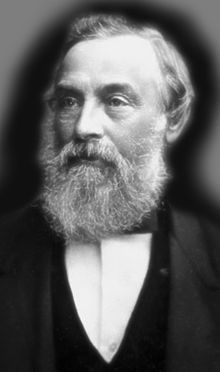Henry Tracey Coxwell
| Henry Tracey Coxwell | |
|---|---|
 |
|
| Born |
2 March 1819 Wouldham |
| Died | 5 January 1900 (aged 80) Seaford, East Sussex |
| Occupation | Balloonist |
Henry Tracey Coxwell (2 March 1819, Wouldham, Kent – 5 January 1900, Lewes, Sussex, England), was an English aeronaut.
He was the youngest son of Commander Joseph Coxwell of the Royal Navy, and grandson of the Rev. Charles Coxwell of Ablington House, Gloucestershire, and was born at the parsonage at Wouldham on 2 March 1819. He went to school at Chatham, where his family moved in 1822, and in 1836 he was apprenticed to a surgeon dentist.
As a boy he became interested in balloons, and he spared no efforts to witness as many ascents as possible; among the aeronauts he admired and envied as a boy were Mrs Graham, Charles Green (balloonist), Robert Cocking and John Hampton. The successful voyage of Green's balloon from Vauxhall Gardens to Germany stimulated his enthusiasm, but it was not until 19 August 1844, at Pentonville, that he had an opportunity of making an ascent.
In the autumn of 1845 he founded and edited The Balloon, or Aerostatic Magazine, of which about twelve numbers appeared at irregular intervals. In 1847 he made a night flight from Vauxhall Gardens with Albert Smith during a storm: a 16 ft (4.9 m) rent appeared in the envelope, and the balloon fell rapidly to earth, the occupants being saved by the balloon catching on some scaffolding before hitting the ground. Undeterred, Coxwell made another flight the following week.
He became a professional balloonist in 1848, when he was entrusted with the management of a balloon, the Sylph, in Brussels, and subsequently made ascents at Antwerp, Elberfeld, Cologne, and Johannisberg in Prussia; in 1849 he exhibited his balloon at Kroll's Gardens, Berlin, and demonstrated the ease with which petards could be discharged in the air; in September he made excursions to Stettin, Breslau, and Hamburg. At Hanover, in the summer of 1850, he had a narrow escape, owing to the proximity of lofty trees, and during this year and the next he took up many passengers at Berlin, Prague, Vienna, Leipzig, and elsewhere. In 1852 he returned to London and made ascents from Cremorne Gardens, the New Globe Gardens in the Mile End Road and the Pavilion Gardens in Woolwich. In September 1854 he made some demonstrations in signalling from a balloon at Surrey Gardens.
...
Wikipedia
